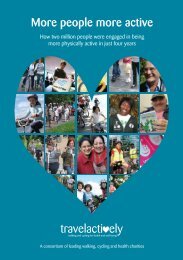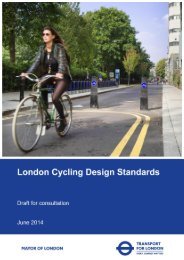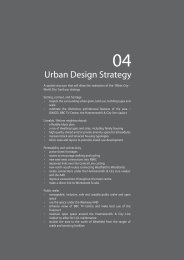Travel in London Travel in London
travel-in-london-report-8
travel-in-london-report-8
Create successful ePaper yourself
Turn your PDF publications into a flip-book with our unique Google optimized e-Paper software.
Overview<br />
upgrade programme, <strong>in</strong>clud<strong>in</strong>g the current renewal of the entire sub-surface<br />
tra<strong>in</strong> fleet, now evident.<br />
• In 2014/15, 489 million vehicle kilometres were operated on the bus network, a<br />
2.4 per cent <strong>in</strong>crease aga<strong>in</strong>st 2008/09, cont<strong>in</strong>u<strong>in</strong>g the high rate of service<br />
provision follow<strong>in</strong>g the major <strong>in</strong>crease to bus service levels <strong>in</strong> the earlier part of<br />
the last decade.<br />
• On the other TfL Rail modes 2014 saw cont<strong>in</strong>ued <strong>in</strong>cremental development to<br />
the networks and the services operated on them. Between 2008/09 and<br />
2013/14, the net <strong>in</strong>creases <strong>in</strong> service provision have been 48.7 per cent on the<br />
DLR and 142.5 per cent on <strong>London</strong> Overground, reflect<strong>in</strong>g the rapid expansion<br />
of this network, and 13.2 per cent on Traml<strong>in</strong>k.<br />
• In terms of the overall capacity provided by the public transport networks,<br />
measured <strong>in</strong> terms of place-kilometres (a reflection of the maximum carry<strong>in</strong>g<br />
capacity of the vehicles), the net <strong>in</strong>creases between 2008/09 and 2014/15 were<br />
9.8 per cent for Underground, 4.3 per cent for bus, 91.9 per cent for DLR and<br />
13.1 per cent for Traml<strong>in</strong>k, equat<strong>in</strong>g to an overall <strong>in</strong>crease of 9.6 per cent across<br />
the four networks <strong>in</strong> comb<strong>in</strong>ation.<br />
• This is a growth rate equivalent to 1.5 per cent per year, on average, <strong>in</strong> the<br />
capacity of <strong>London</strong>’s key public transport networks. Despite fall<strong>in</strong>g short of the<br />
overall <strong>in</strong>crease <strong>in</strong> travel demand, <strong>in</strong>dices of customer satisfaction with crowd<strong>in</strong>g<br />
on the public transport networks have improved over the period.<br />
Alongside <strong>in</strong>creased public transport provision, there have also been susta<strong>in</strong>ed<br />
improvements to the quality and reliability of public transport services, and<br />
correspond<strong>in</strong>g <strong>in</strong>creases <strong>in</strong> customer satisfaction.<br />
• Service reliability <strong>in</strong>dicators <strong>in</strong> 2014/15 for the major public transport modes<br />
were also at, or close to, best-ever levels, follow<strong>in</strong>g on from and ma<strong>in</strong>ta<strong>in</strong><strong>in</strong>g the<br />
exceptional performance to support the <strong>London</strong> 2012 Olympic and Paralympic<br />
Games. <strong>London</strong>’s public transport networks now carry more people, more<br />
reliably, than ever before.<br />
• In 2014/15 <strong>London</strong> Underground operated 80 million tra<strong>in</strong> kilometres, reflect<strong>in</strong>g<br />
97.6 per cent reliability, aga<strong>in</strong>st 73 million tra<strong>in</strong> kilometres operated <strong>in</strong> 2008/09,<br />
reflect<strong>in</strong>g 96.4 per cent reliability. In terms of customer-focused measures,<br />
excess journey time for the Underground has reduced from an average of 6.6<br />
m<strong>in</strong>utes <strong>in</strong> 2008/09 to 4.6 m<strong>in</strong>utes <strong>in</strong> 2014/15, a reduction of 30.3 per cent <strong>in</strong><br />
this measure of unreliability.<br />
• Bus reliability, <strong>in</strong> terms of the percentage of schedule operated, has been at<br />
consistently high levels throughout the period from 2008/09. In 2014/15 97.1<br />
per cent of the schedule was operated, compared with 97.2 per cent <strong>in</strong> 2008/09.<br />
Achiev<strong>in</strong>g and ma<strong>in</strong>ta<strong>in</strong><strong>in</strong>g these high levels of bus network reliability has been a<br />
major feature of the period s<strong>in</strong>ce 2000. In terms of excess wait<strong>in</strong>g times, for<br />
much of the period s<strong>in</strong>ce 2008 the average bus passenger has had to wait just<br />
one m<strong>in</strong>ute longer than they would otherwise have to do if the service ran<br />
perfectly to schedule, although this has <strong>in</strong>creased to 1.1 m<strong>in</strong>utes <strong>in</strong> 2014/15,<br />
and there are signs that wider congestion trends dur<strong>in</strong>g 2015 are beg<strong>in</strong>n<strong>in</strong>g to<br />
impact on bus service reliability.<br />
11 <strong>Travel</strong> <strong>in</strong> <strong>London</strong>, Report 8








